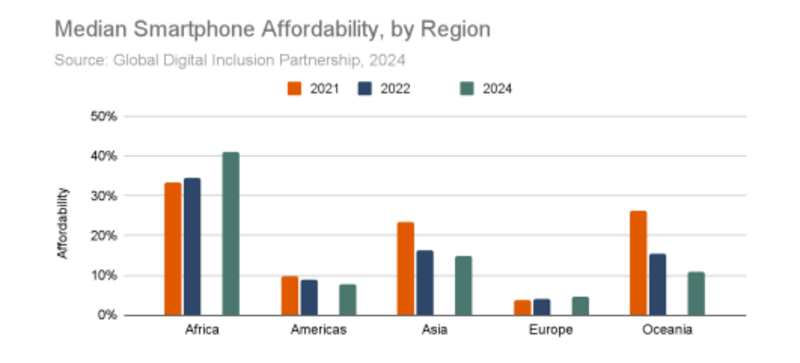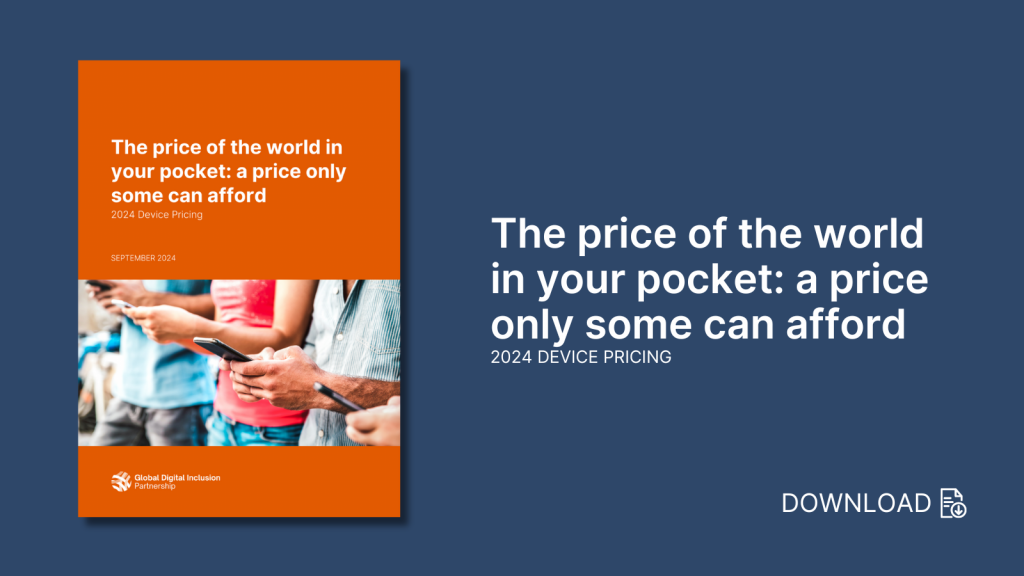Device affordability remains an urgent concern for inclusive digital economies. As policymakers and industry work to bridge the device affordability gap, this research helps track progress towards universal and meaningful connectivity. Critically, a personal, internet-capable device like a smartphone is one of the four pillars of meaningful connectivity. Without affordable devices, we will never reach our goals of scalable digital economies and sustainable digital transformation.
Today, the Global Digital Inclusion Partnership (GDIP) publishes reference prices for smartphones and feature phones in 171 markets. These markets span across all continents, sizes, and income levels to give as comprehensive a picture as possible of what prices consumers are paying in the market for a device. This data was collected through June 2024 according to the same methodology that maintains consistency with similar data collected in 2021 and 2022.

Source: GDIP The price of the world in your pocket – a price only some can afford (page 6)
Key figures from the dataset:
- The median price for a smartphone globally is US$92.59. The lowest regional median price is in Africa, at $60.23, while the highest is $101.88 in the Americas.
- The median global affordability (defined as price as a percentage of average monthly income) for a smartphone is 11%. Europe has the greatest regional affordability, at 4.5%, while Africa has the least, at 41%.
- The median smartphone price among low-income countries is $36.62, rising in line between price and income groups, with the median smartphone price among high-income countries at $121.49.
- Feature phones offer a lower price point. The global median price for an internet-capable feature phone is $25, at 5.53% affordability.
From this research, here’s what we know:
- In most markets, smartphone prices have remained relatively stable. Set against rising average incomes from the post-pandemic economic recovery, this means devices are becoming more affordable.
- Common strategies for bridging the affordability gap for devices – original device manufacturers (ODMs) and feature phones – are increasingly infrequent across markets.
- Huge disparities remain in device affordability. This particularly affects those in low-income countries where production lines may be less stable, and consumers have less disposable income to spend on devices, especially marginalized groups such as women and those in rural areas, where average incomes are lower.
In total, the picture of global device affordability indicates positive, gradual change. However, affordability remains a critical change in low-income and lower-middle-income countries, where the cheapest smartphone on offer in those countries represents over a week’s worth of the average income in those countries. Policymakers looking to accelerate economic growth through digitalization need to take care of these foundations – such as device affordability – to ensure that all are able to participate and benefit from the transformations that these technologies may bear.

About GDIP
The Global Digital Inclusion Partnership is a coalition of public, private, and civil society organizations working to bring internet connectivity to the global majority and ensure everyone is meaningfully connected by 2030. GDIP advances digital opportunities to empower and support people’s lives and agency, leading to inclusive digital societies.